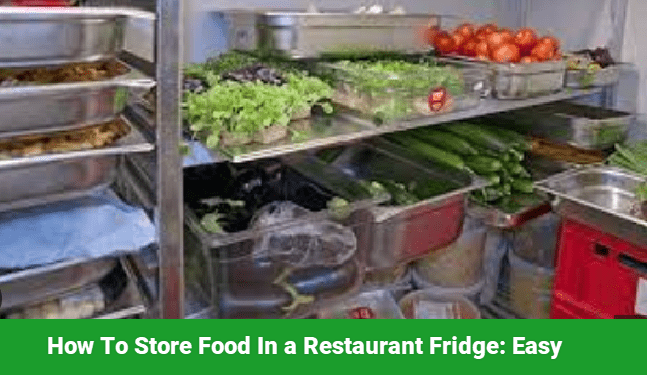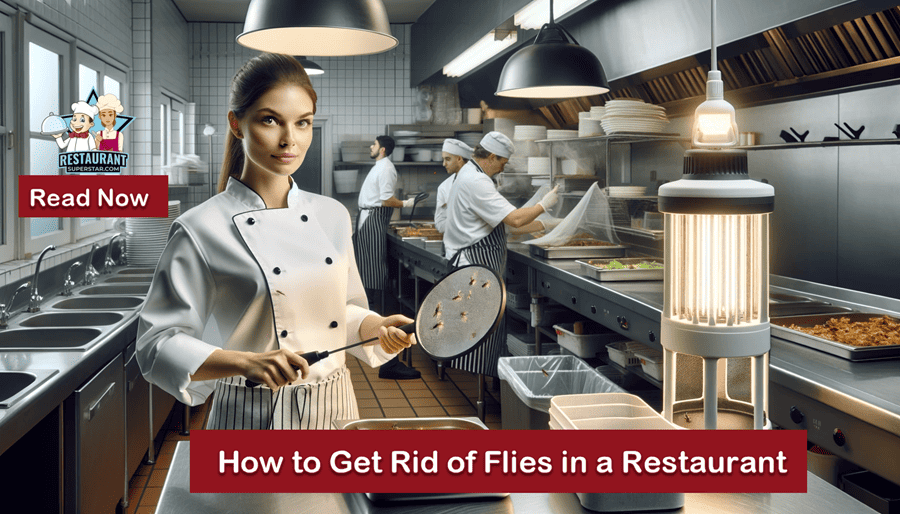How To Store Food In a Restaurant Fridge: Easy

Don’t Let Your Food Go to Waste: Tips for Proper Restaurant Fridge Storage
Hey there,
If you were wondering,
How To Store Food In a Restaurant Fridge?
You are in the right place.
Welcome to our guide on how to store food in a restaurant fridge. As a restaurateur or executive chef, you are well aware of the paramount importance of maintaining your ingredients fresh and safe to consume.
However, with the hustle and bustle of the kitchen, it can be easy to overlook proper storage techniques. That’s where we come in. In this post, we’ll share tips and tricks for storing food in a restaurant fridge to help you maintain the quality and safety of your ingredients.
From organizing your fridge to choosing the proper containers and labeling your items, we’ll cover everything you need to know to keep your food fresh and avoid waste.
We’ll also review some common mistakes and important food safety guidelines.
With our expert advice, you’ll be able to maximize the lifespan of your ingredients and save money in the long run. Now, let’s catch up and discover how to expertly store food in a restaurant fridge.
How To Store Food In a Restaurant Fridge?
How To Store Food In a Restaurant Fridge? Organize the fridge properly, use airtight containers, and label everything. Avoid cross-contamination and follow food safety guidelines. These simple steps will help you reduce waste and save money in the long run.
How To Store Food In a Restaurant Fridge made easy: a step-by-step Guide.
Are you sick of watching your hard-earned profits go down the drain with each bowl of spoiled food served in your restaurant? Our easy step-by-step guide on storing food in a restaurant fridge has got you covered.
Here are 17 steps for storing food in a restaurant fridge:
1 – Check Fridge Temp
It’s essential to ensure the refrigerator maintains a temperature of 40°F or below. This is the optimal temperature range for food safety and will help prevent the growth of harmful bacteria that can cause foodborne illness.
To test the temperature of your refrigerator, insert a thermometer into its warmest region, such as the top shelf, for an accurate reading.
Wait a few minutes for an accurate reading. If the temperature is too high, adjust the settings accordingly and wait a few hours before checking again.
Regularly monitoring the temperature of your restaurant fridge is crucial for ensuring that your food stays fresh and safe to consume. By following this simple step, you can avoid food spoilage, reduce waste, and maintain a high food safety standard for your customers.
2 – Organize by Food Category
This helps prevent cross-contamination and ensures that foods with different temperatures and storage requirements are stored in the appropriate places.
To organize the fridge, group similar foods together. For example, store raw meats on the bottom shelf to prevent drips onto other foods. Place cooked foods on a higher shelf to prevent them from coming into contact with raw meats or juices. Keep dairy products on the top shelf where the temperature is most consistent.
Additionally, separate raw fruits and vegetables from raw meats to avoid cross-contamination. It’s also vital to keep ready-to-eat foods in a different area from raw foods to prevent contamination.
Rearranging your refrigerator in this fashion can greatly reduce the risk of bacteria growth, safeguarding against food spoilage and keeping it safe to consume. This simple step can go a long way in maintaining the quality and safety of your ingredients.
3 – Store Raw Meat on Bottom Shelf
This is important to prevent drips or spills from contaminating other foods in the refrigerator.
Uncooked meat harbors dangerous bacteria, including Salmonella and E. coli, which can contaminate other foods if cross-contact happens and lead to food poisoning. Storing raw meat on the bottom shelf can prevent potential drips or spills from contaminating other foods.
Store raw meat separately to prevent cross-contamination is also a good idea. Make sure the container is leak-proof and labeled with the date and contents. This will help you keep track of freshness and ensure that you use older meat before it expires.
By following this simple step, you can help prevent the spread of harmful bacteria and ensure your food stays fresh and safe for consumption. Proper food storage is essential for maintaining the quality and safety of your ingredients.
4 – Keep Cooked Foods Higher
This is important to prevent any drips or spills from raw meats from contaminating cooked foods.
Cooked foods are generally safer to eat than raw meats, but they can still become contaminated if they come into contact with raw meats. Storing cooked foods on a higher shelf can prevent potential drips or spills from infecting them.
It’s also a good idea to store cooked foods separately from raw meats. This will further prevent cross-contamination and help you keep track of the freshness of your ingredients. Make sure the containers are labeled with the date and contents to ensure that you use older items first.
By following this simple step, you can help prevent the spread of harmful bacteria and ensure your food stays fresh and safe for consumption. Proper food storage is essential for maintaining the quality and safety of your ingredients, and this step is a key part of that process.
5 – Use Airtight Containers
Using suitable containers is important to prevent leaks or spills contaminating other foods in the refrigerator.
Use containers that are leak-proof and have tight-fitting lids to prevent any spills or drips. Make sure the containers are labeled with the date and contents to ensure that you use older items first.
It’s also a good idea to use clear containers to see what’s inside easily. Utilizing this system will help you monitor the freshness of your ingredients, guaranteeing that they are used before their expiration date.
Properly storing your ingredients in the right containers will help prevent food spoilage and ensure that your food stays fresh and safe for consumption. Investing in high-quality storage containers to maintain the quality of your ingredients and prevent any potential foodborne illnesses is important.
6 – Label Containers with Date
Another critical step in storing food in a restaurant fridge is to label containers with the date. This is important for several reasons. To begin with, labeling your containers with the date will ensure you remain up to speed on how fresh your ingredients are.
This will ensure you use older items first and prevent potential food spoilage. Second, labeling containers will help you identify the contents quickly and easily. This is especially important in a busy kitchen where time is of the essence.
Finally, labeling containers with the date is important for food safety. It will help you identify any items in the fridge for too long and should be discarded. By taking this simple step, you can help prevent food waste, maintain the quality of your ingredients, and ensure the safety of your customers.
7 – Use clear containers
Clear containers are another crucial step in storing food in a restaurant fridge. Clear containers make it easy to see the contents of each container, which is essential for keeping track of what ingredients you have on hand.
This is especially important in a busy kitchen where time is of the essence. By using clear containers, you can quickly identify the ingredients you need and ensure that you use older items first. Clear containers also help you monitor the freshness of your ingredients.
You can quickly identify any items that are starting to spoil and use them before they go bad. This will help prevent food waste and ensure your ingredients are always fresh and safe for consumption.
Investing in pristine containers is crucial to preserving the integrity of your ingredients and executing an efficient restaurant. With one small decision, you can potentially have huge outcomes for your business.
8 – Keep Raw Fruits/Veggies Separate
Keeping raw fruits and veggies separate from other food items is another crucial step in storing food in a restaurant fridge. Raw fruits and veggies can carry harmful bacteria that can contaminate other food items if they come into contact with each other.
Store raw fruits and veggies in a separate container or drawer to prevent this. Ensure the container is labeled with the contents and date so you can use older items first.
By storing raw fruits and veggies separately, you can prevent the spread of harmful bacteria and ensure your food stays fresh and safe for consumption.
This is especially important in a restaurant where you serve many people large quantities of food. This simple step can help prevent foodborne illnesses and ensure the safety of your customers.
9 – Separate Ready-to-eat Foods
Another critical step for storing food in a restaurant fridge is to separate ready-to-eat foods from raw food items. Ready-to-eat foods like cooked meats, salads, and pre-cooked vegetables should be stored on a separate shelf or in a container from raw food items.
This will help prevent cross-contamination and reduce the risk of foodborne illnesses. When storing ready-to-eat foods, cover them with a lid or wrap to prevent them from drying out or becoming contaminated.
Be sure to label the containers with the date and contents to ensure that you use older items first. By separating ready-to-eat foods from raw food items, you can maintain the quality and safety of your food and ensure that your customers are served fresh, delicious meals that are safe to eat.
10 – Store Dairy Products on Top Shelf
Dairy products should be stored on the top shelf of the restaurant fridge. This is because the top shelf is the coldest part of the fridge, and dairy products must be kept at a consistent, cold temperature to maintain their freshness and safety.
When storing dairy products like milk, cheese, and yogurt, keep them in a tightly sealed container to prevent odors from other foods from contaminating them.
Also, it’s essential to label the containers with the contents and the date so that you can use older items first.
By following these simple steps, you can ensure that your dairy products are always fresh and safe to consume, which is essential for the success of any restaurant. So remember, store your dairy products on the fridge’s top shelf, and keep them tightly sealed and labeled for best results.
11 – Rotate Food
Rotating food is an important step in storing food in a restaurant fridge. This means you should use older items first and move newer items to the back of the refrigerator. Doing this can prevent food from spoiling and reduce the risk of foodborne illnesses.
To rotate your food, make sure that you label your containers with the date and contents so that you can keep track of when they were stored.
When stocking your fridge, place the older items in the front, which is easy to reach, and the newer items in the back. This practice guarantees that you are always using the oldest items first.
Rotating your food is an essential step in maintaining the quality and safety of your food, and it’s easy to do. So remember, rotate your food regularly and label your containers for the best results.
12 – Keep Fridge Clean
Keeping the fridge clean is essential in storing food in a restaurant fridge. A clean fridge reduces the risk of cross-contamination and ensures your food is fresh and safe.
Regularly cleaning your fridge also helps maintain the refrigerator’s quality and lifespan. To keep your fridge clean, wipe down the shelves and drawers regularly with a mild cleaning solution.
Also, check for spills and leaks, and clean them up immediately. Additionally, regularly check the fridge’s temperature to ensure it functions correctly.
Keeping your fridge clean can create a safe and healthy environment for your food, which is crucial for the success of any restaurant. So don’t forget to clean your fridge regularly and maintain the quality and safety of your food.
13 – Avoid overfilling
Overfilling the fridge is a common mistake many restaurant owners make when storing food in the refrigerator. Overfilling can cause the refrigerator to run less efficiently and can lead to food spoilage.
When you overfill the refrigerator, there is less air circulation, which can cause hot spots and cold spots, leading to food spoilage. Additionally, it can be difficult to see what is in the fridge when it is overfilled, making it challenging to rotate food and maintain proper food storage practices.
To avoid overfilling the refrigerator, plan out your storage space and avoid cramming too much into a small space. If running out of room, consider purchasing an additional fridge or freezer to store excess food.
Avoiding overfilling can keep your food fresh and safe and maintain a healthy and organized restaurant kitchen.
14 – Check Fridge Temp Regularly
Regularly checking the temperature of your restaurant fridge is an essential step in storing food safely. The temperature of your fridge should be between 32 and 40 degrees Fahrenheit to ensure that your food stays fresh and doesn’t spoil.
Checking the temperature regularly helps ensure that the fridge functions correctly and your food is stored at the correct temperature.
Checking the temperature of your fridge daily is a wise choice, especially during high-traffic times when it might be open and closed more often. Ensure you check your refrigerator’s temperatures to guarantee safety and freshness.
If the temperature is not within the recommended range, it’s crucial to take action immediately to avoid the risk of food spoilage.
Adjusting the temperature, cleaning the fridge, and removing any items blocking the airflow can help maintain the fridge’s proper temperature. By checking the fridge temperature regularly, you can ensure that your food stays fresh and safe to eat, which is crucial for the success of any restaurant.
15 – Use a Separate Fridge for Drinks
A separate fridge for drinks is a smart way to keep your restaurant fridge organized and avoid cross-contamination. Drinks can take up a lot of space in the refrigerator, especially during busy periods, making it challenging to store food properly.
Using a separate fridge for drinks, you can free up space in your main fridge for food and ensure the temperature stays consistent. Also, drinks can sometimes leak or spill, contaminating food and making it unsafe to eat.
By keeping drinks in a separate fridge, you can avoid the risk of cross-contamination and ensure that your food stays fresh and safe. It’s also a good idea to label the drink fridge clearly to make it easy for staff to locate drinks quickly and efficiently.
Using a separate fridge for drinks, you can maintain an organized and efficient restaurant kitchen and provide your customers with fresh, safe, and delicious food.
16 – Use a Separate Fridge for Allergen-free Foods
A separate fridge for allergen-free foods is critical in preventing cross-contamination in a restaurant kitchen. Allergen-free foods must be stored separately from other foods to avoid contact with allergens that can cause serious health issues for customers.
Using a separate fridge can avoid the risk of cross-contamination and ensure that customers with allergies can safely enjoy your restaurant’s food.
Make sure to label the allergen-free fridge clearly to avoid confusion and ensure that staff members understand the importance of keeping allergen-free foods separate from others.
It’s also essential to ensure that the allergen-free fridge is cleaned regularly to prevent the buildup of any allergens or bacteria that could contaminate the food.
By using a separate fridge for allergen-free foods, you can demonstrate a commitment to the safety and well-being of your customers and create a welcoming environment for all diners.
17 – Train staff on storage procedures
Proper training of staff on storage procedures is crucial to ensure that food is stored safely in a restaurant fridge.
All employees who handle food should be trained to correctly store food in the fridge, including how to label containers, separate raw foods from ready-to-eat foods, and avoid overfilling.
The training should also cover the importance of regularly checking the fridge’s temperature to ensure it is within safe limits. By training your staff on proper storage procedures, you can ensure that everyone in the kitchen is on the same page and that food is stored correctly every time.
This can help prevent foodborne illness and ensure customers receive safe, high-quality food. Remember to provide regular refresher training to staff members to ensure that they stay updated on any procedure changes and continue to follow best practices for food storage.
Conclusion: How To Store Food In a Restaurant Fridge
In conclusion, knowing how to store food in a restaurant fridge is essential to prevent the growth of harmful bacteria and ensure customers’ safety.
By adhering to the guidelines presented in this guide, you can store food safely and hygienically within your restaurant’s refrigerator.
Remember to label containers with dates, separate raw fruits and vegetables, use clear containers, and rotate food regularly. Additionally, it is important to keep the fridge clean, avoid overfilling and check the temperature regularly to ensure it is within safe limits.
Finally, train your staff on proper storage procedures to ensure that everyone in the kitchen is on the same page and that food is stored correctly every time. Following these guidelines can help prevent foodborne illness and provide your customers safe, high-quality food.




